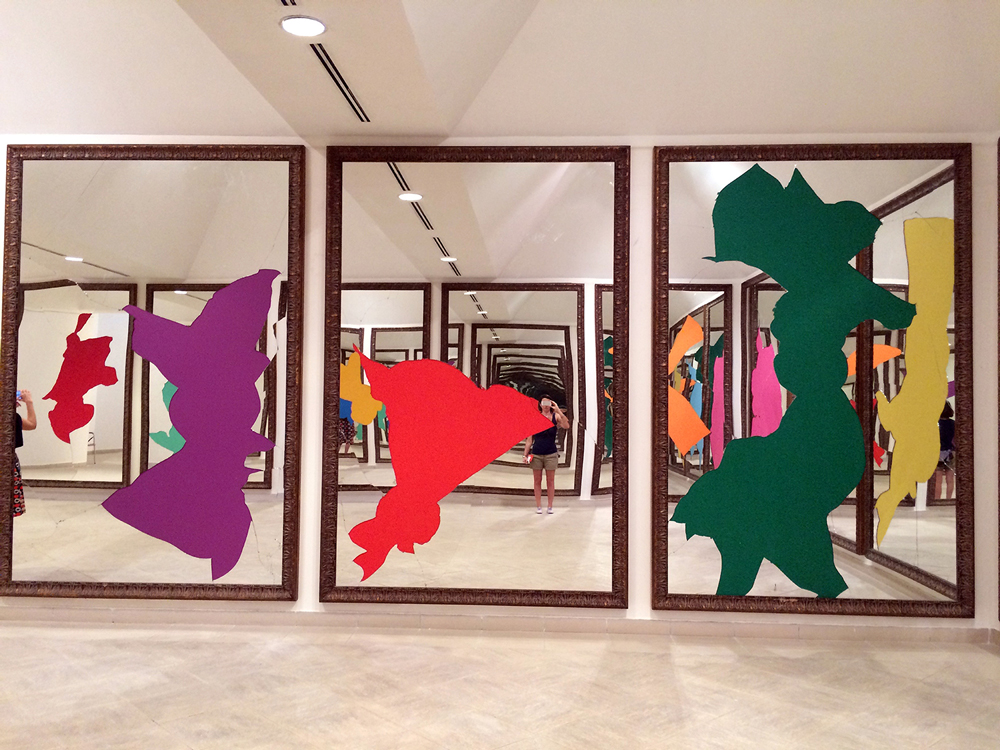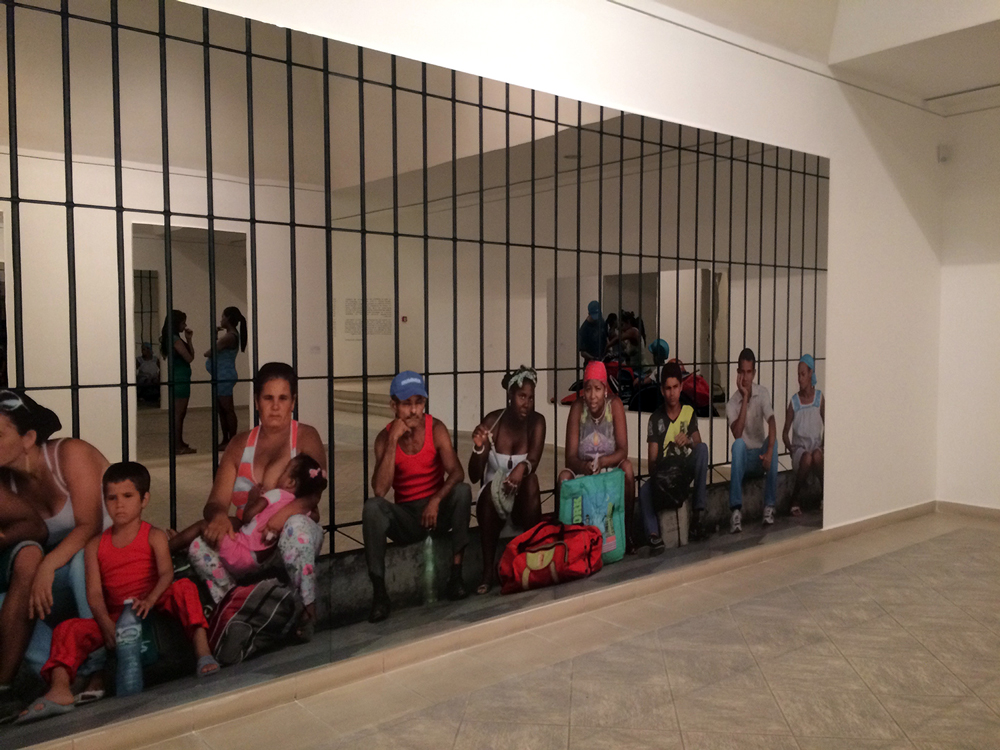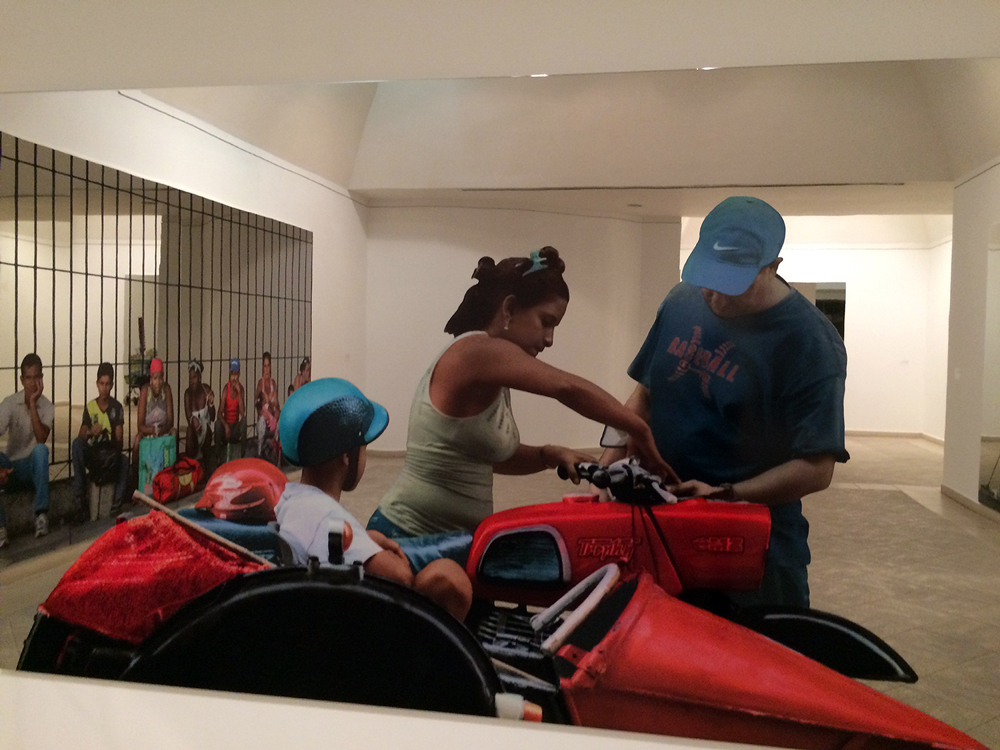Michelangelo Pistoletto’s solo exhibition held at the Museo Nacional de Bellas Artes de La Habana between November 2016 and March 2017, was a celebration of his political, social, and artistic involvement in the Cuban capital, as well as his spatio-temporal aesthetic experimentations with mirroring. The exhibit that closed on March 13 was an ode to Pistoletto’s lifetime oeuvre. Two floors of the Arte Universal pavilion were populated by his art. The first, which welcomes visitors, was dedicated to his solo exhibition, and highlighted his Havana-based new work; while on the second floor past works fused and intermingled with the Bellas Arte’s permanent collection, a signature-exhibiting scheme of this prominent figure of the Arte Povera movement, who likes to put his art in dialogue with museums’ collections and spaces. The wide range of selections included his experimentations of the 1960s and 1970s with objects, materials, and photography: from Oggetti in Meno (Minus Objects, 1965-1966), to his photographic series La Conferenza and Raggi di persone (The conference and People’s rays, 1975). On the way to the museum’s Ancient Art section stood the more emblematic Arte Povera-inspired Venere degli stracci(Venus of the Rags, 1967-1974), a marmoreal white neo-classical status of Venus looking down at an immense pile of colorful rags, that dwarfs her monumentality.

Specularity, Time, and Techniques
Pistoletto’s experimentation with specularity, multiplicity, and fragmentarity, and his new Cuban everyday life-based series were the most exquisite, delicate, and political elements of the exhibit. The artist’s interest in mirrors dates back to 1970, coming out of his research into time and memory, division and multiplication. The solo exhibit offered a retrospective of his experimentations in specularity, from Mirror Cage – Double Square(1975-2007), Two Less One (2009-2011), Buco Nero (Black Hole, 2010) and Vortice (Vortex 2010-2013). Thirteen less one is the first mirror series conceived in Havana. It is the result of Pistoletto’s performance The breaking of the mirror at the 12th Havana Biennale in 2015 where the artist, in front of an astonished crowd, smashed the mirrors into a myriad of fragments with a big hammer. The 13 broken mirrors form part of the Museum’s permanent collection today. The act of breaking a mirror for Pistoletto is related to the multiplication of its pieces and reflections, rather than its material destruction, and is deeply linked to his research into “the fourth dimension; seen here through the relationship between the present and memory,” as he explains in the text accompanying the artwork. Forms, shapes, cracks, and holes created by the act of breaking are frozen in the now-exhibited broken mirrors as a memory of the past, the reflecting surfaces incessantly revealing the ever-changing moment.
Time is one of the major topics Pistoletto explores in his work, particularly in his mirror series. And, it was over a lengthy period of time, that the artist developed a specific technique of silk-screening images onto highly reflective stainless steel. In the 1960s’, his first experiments would include a photographic image trimmed and superimposed onto a mirror surface. As Pistoletto writes in his own description of the development of his technique: this first practice would still produce a dichotomy between the materiality of the photographic image on the mirror surface and the immateriality of the reflected images. Conversely, Pistoletto’s main objective was to create an immersive “moment” where the still image from the past fuses and interacts with the moving image of the present and its environment. In 1971, after several experimentations, including tracing real-size photographs with a brush through vellum paper onto stainless steel surfaces, he perfected his own technique of using silk-screen printing, a procedure made famous in the same period by Pop Art artist Andy Warhol. Unlike Pop Art, however, Pistoletto’s artworks are always unique. Using reproducible techniques such as photography and silk-screen printing (also known as serigraphy), the artist creates a unique visual and virtual work of art, which is not reproduced in series and that lives in the present moment through reflection and participation. As Walter Benjamin writes in his well known essay “The Work of Art in the Age of Mechanical Reproduction”:
“In principle a work of art has always been reproducible. […] Even the most perfect reproduction of a work of art is lacking in one element: its presence in time and space, its unique existence at the place where it happens to be. This unique existence of the work of art determined the history to which it was subject throughout the time of its existence.” (Benjamin, 1969)
Pistoletto’s Mirror paintings are unique exactly because of their “presence in time and space,” which is made possible by the artist’s life-long research into the temporal dimension and participation through the combination of techniques and media.

Havana Street-life : 18 Mirror Paintings
Following this research into the relationship between present and past, the 18 Mirror Paintings explicitly conceived for this exhibit brought Havana’s street-life scenes into the Bellas Artes. These silkscreened, life-size photographic images of Habaneras and Habaneros printed on top of mirroring surfaces bring the viewer to the role of participant into an everyday life scene. A typical Havana three-wheel coco-taxi drives through the streets of the city, mother and daughter play on a swing, a street-vendor sells peanuts and rositas de mais, men play chess, a family gets ready to take a ride on a sidecar, women buy colorful fruits at a kiosk. These are some of the eighteen scenes you can participate in – for you will find yourself included in the picture, your image playing and reflecting on its surface. The eighteen mirrors return still images of Cuban society at given moments in the past, through the silkscreened technique – moments that are constantly made anew by its reflective properties as the changing reflections are viewed and experienced in the present moment. They bring you back into the crowded, lively and busy streets that you have strolled through to enter the museum.
As Pistoletto states, one of the themes he aims at exploring with his mirror paintings, other than time, is “inclusion” – not only of the viewer, but also of the surrounding environment, making his artwork a “self-portrait of the world […]in a [constant] interaction between the photographic image and what happens in the virtual space generated by the mirroring surface.” (translation from Quadri specchianti) Oliver Grau’s essay on Virtual Artreflects upon the impossibility of the uniqueness of a work of art described by Walter Benjamin in relation to virtual reality techniques and digital art. He writes:
“Compared with traditional images and their fixed materiality, digital or virtual images are categorically different. […] For an artwork of virtual reality, which knows no original, connotations of the cult of uniqueness, in the sense used by Walter Benjamin, do not obtain.” (Grau, 2003, p. 249)

Yet, even if different from digital artwork, we can consider Pistoletto’s mirror paintings as media art which is able to create a virtual environment through reproducible techniques and digital tools playing with materials’ properties and encouraging inclusion and participation. The environment is created by the still past of the photographic image and the reflected surroundings of the artwork. Following again Grau’s writings, “many virtual environments reduce the observer to a disembodied state within a Cartesian space that is clear for miles around and often quite empty.” (Grau, 2003, p. 193) Such a conception of a Cartesian empty space can be also found in architecture and design, as architect Greg Lynn underlines:
“traditionally, in architecture, the abstract space of design is conceived as an ideal neutral space of Cartesian coordinates. In other design fields, however, design space is conceived as an environment of force and motion rather than as a neutral vacuum.” (Lynn, 1999, p. 10)
In 18 Mirror Paintings, Pistoletto draws on interplaying forces to create inclusion: not only does the observer maintains her bodily presence by way of her reflection on the surface of the work of art, but she does so in an ecological relationship to time and space. She is immersed and reflected within her ever-changing environment, while interacting with the stillness and past of the photographic image. The silk-screen techniques and digital tools used to enlarge and print life-size photographic images onto the mirror surface provide a bodily and textured presence of the image itself, which becomes part of the environment reflected into the mirror, and is made anew by every single interaction.

Performance and Participation
Together with time and inclusion, participation is another key feature in Pistoletto’s work. His artistic involvement in Cuban everyday life is socially and politically oriented. Since 2014, he has been working with local artists to create collaborative performances, and to create a base for his Galleria Continua, in an ancient 1950’s movie theatre in Centro Habana’s Chinatown. In 2014, Pistoletto organized the first Rebirth Forum “Geographies of Change” in collaboration with the United Nations and local artists and institutions, establishing the Cuban Rebirth Embassy. Along with his “diplomatic-artistic” work, a performance inspired by Pistoletto’s symbol of “Rebirth” (a three-circle symbol created by the artist, that combines an infinity symbol of continuity between the natural and artificial, with a third circle of transformation) was staged, in collaboration with Cuban artist Alexis Leiva Kcho, with fishermen’s boats floating in three circles in the sea in front of Havana. This took place on 16 December 2014, the day before former-President Obama and Raul Castro announced the reestablishment of diplomatic relations between the two countries. The impact of the performance was not only timely and political, but also spatial and social. The sea, for Cubans, represents hope and despair, life and death. Source of life and sustainment that is limited by strict sailing regulation, but also hope for building relationships, and death and despair for those who tried to escape the isolation the island has witnessed through the years and never came back.
In 2016, Pistoletto organized the Third Re-birth Forum in Havana, opening his solo exhibition on November 25. A Walking sculpture, inspired by his 1967 Sfera di giornali, rolled through the streets of Havana to reach the exhibition at the museum, intended to bring luck and transformative power to everyone and everything it touched on its way. The sphere, made out of magazines and journals’ pages, relates to the media aspect of Pistoletto’s artwork. Not only is it made with the classic quintessential form of medium, the newspaper, but it is a medium itself circulating through the streets and interacting with the city’s material and bodily elements, prompting an understanding of media, and in this case of media art, as “mobile forms circulating within social space.” (Straw, 2010, p. 23)
For Pistoletto, art is a generative tool for social and political change, and the artist is an ambassador of civic engagement and transformation. Moreover, Cuba represents for him a mirror holding the past of a binomial power structure between the two poles of Communism and Capitalism, and reflects the changing moment of transition in the country and the world, offering glimpses of a possible better future. In the aftermath of his performance, Pistoletto wrote a letter to Barack Obama and Raul Castro, published on the page of his Galleria continua, where he makes clear his vision of art as a powerful socio-political generative tool:
“On November 23, 2015, I was received by Raul Castro at the Palace of the Revolution? Along with the artist Kcho. During a long conversation, the president declared himself to be fully in agreement with the import of the Rebirth-Third Paradise symbol, expressing the conviction that it could serve as a guide to the establishment of a new political balance, both locally and globally. A balance indispensable to overcoming the conflicts that divided the world with the Cold War and that are now reemerging in a new form all over the planet. Personally I believe that Cuba is symbolically and practically the place from which to start over. From the following day until November 26, the 1st Rebirth Forum— Geographies of Transformation was held in Havana. On that occasion we showed that it is possible to set practices of responsible change in motion through art, reconciling the different and opposing positions that condition society and politics.”
Bibliographie
– Benjamin, Walter, «The Work of Art in the Age of Mechanical Reproduction», dans Hannah Arendt, Illuminations, New York, Schocken Books, 1969, en ligne, ,https://web.mit.edu/allanmc/www/benjamin.pdf>, consulté le 6 avril 2017.
– Grau, Oliver, Virtual art: from illusion to immersion, Cambridge, MIT Press,2003, 430 p.
– Lynn, Greg, Animate Forms. New York, Princeton Architectural Press, 1999, 128 p.
– Straw, Will, «The Circulatory Turn», dans Barbara Crow, Michael Longford, et Kim Sawchuk, The Wireless Spectrum: The Politics, Practices and Poetics of Mobile Media, Toronto, University of Toronto Press, p. 17-28.
